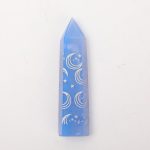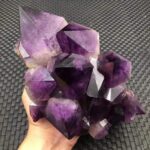Introduction
The world of gemstones is a treasure trove of colors and properties, with pink and green stones occupying a prominent place in the spectrum. These vibrant hues evoke a sense of elegance, tranquility, and wealth, making them highly sought after for jewelry, decorative objects, and investments.

Types of Pink Stones
1. Pink Diamond
- Hardness: 10 on the Mohs scale
- Color: Varies from light pink to deep rose
- Occurrence: Mined primarily in Western Australia, Russia, and Canada
- Value: The rarest and most valuable of pink stones, with prices ranging from thousands to millions of dollars per carat
2. Pink Sapphire
- Hardness: 9 on the Mohs scale
- Color: Pale pink to deep salmon
- Occurrence: Found in Sri Lanka, Madagascar, and Australia
- Value: More affordable than pink diamonds, with prices typically ranging from hundreds to thousands of dollars per carat
3. Pink Morganite
- Hardness: 7.5 on the Mohs scale
- Color: Soft pink to peach
- Occurrence: Mined in Brazil, Madagascar, and the United States
- Value: Relatively inexpensive, with prices ranging from tens to hundreds of dollars per carat
Types of Green Stones
1. Emerald
- Hardness: 7.5-8 on the Mohs scale
- Color: Deep, vibrant green
- Occurrence: Mined in Colombia, Zambia, and Brazil
- Value: One of the most expensive gemstones, with high-quality emeralds fetching hundreds of thousands of dollars per carat
2. Peridot
- Hardness: 6.5-7 on the Mohs scale
- Color: Olive green to yellow-green
- Occurrence: Found in volcanic rocks in Hawaii, Arizona, and China
- Value: More affordable than emeralds, with prices typically ranging from tens to hundreds of dollars per carat
3. Green Tourmaline
- Hardness: 7-7.5 on the Mohs scale
- Color: Varies from pale green to deep forest green
- Occurrence: Mined in Brazil, Africa, and the United States
- Value: Less valuable than emeralds and peridots, with prices ranging from tens to thousands of dollars per carat
Applications of Pink and Green Stones
These gemstones find a wide range of applications, including:
- Jewelry: Earrings, necklaces, bracelets, and rings adorned with pink and green stones are highly popular among collectors and fashion enthusiasts.
- Decorative Objects: Vases, figurines, and sculptures made from or incorporating pink and green stones add a touch of elegance and opulence to any space.
- Investments: Pink and green stones, particularly diamonds, are considered a safe asset class and can appreciate in value over time.
Investment Potential
According to the Gemological Institute of America (GIA), the value of pink and green gemstones has increased significantly in recent years. For example, the average price of a 1-carat pink diamond rose by over 300% from 2010 to 2020. Similarly, the value of emeralds has increased by an average of 5% per year over the past decade.
Common Mistakes to Avoid
When investing in pink and green stones, it is essential to avoid common mistakes, such as:
- Buying without a certificate: Always purchase gemstones that come with a certificate from a reputable laboratory, such as the GIA or the International Gemological Institute (IGI).
- Overpaying for color: While color is a key factor in determining the value of a gemstone, it is important to avoid paying a premium for stones with overly saturated or artificial-looking colors.
- Investing in low-quality stones: Low-quality gemstones with inclusions, scratches, or other imperfections will have a lower resale value.
Frequently Asked Questions
1. What is the difference between a pink diamond and a pink sapphire?
Pink diamonds are much rarer and more valuable than pink sapphires. They also have a higher refractive index, which makes them sparkle more brilliantly.
2. How can I tell if an emerald is real?
Genuine emeralds often have inclusions or tiny cracks, known as “jardin.” These inclusions are unique to emeralds and can be used to identify them from imitations.
3. Can peridot change color?
No, peridot is a stable gemstone that does not change color under normal conditions.
4. Are pink and green stones good investments?
Pink and green stones, particularly diamonds and emeralds, can be good investments if purchased carefully and with a long-term perspective.
5. How should I store pink and green stones?
Store your gemstones in a cool, dry place away from direct sunlight. Wrap them in soft cloth or store them in a jewelry box to prevent scratches.
Creative New Word: “Gemophy”
To spark innovation in the application of pink and green stones, we introduce the neologism “gemophy,” which captures the convergence of gemology and physiology. This concept inspires the exploration of how gemstones can positively impact physical and mental well-being, leading to new applications in jewelry, therapy, and wearable technology.
Conclusion
Pink and green stones are a captivating class of gemstones that evoke beauty, elegance, and value. Understanding their types, properties, and applications empowers collectors, investors, and designers to harness their unique allure. By embracing innovative concepts like “gemophy,” we can unlock new possibilities and appreciate these extraordinary stones for their aesthetic, economic, and therapeutic benefits.




























